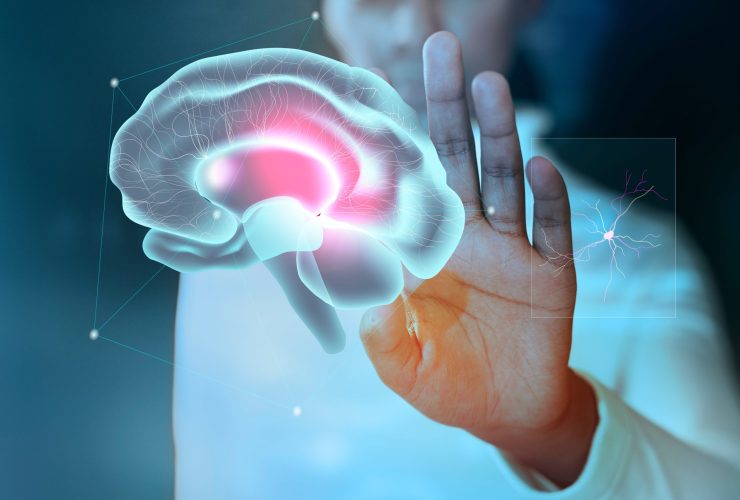A maioria dos tecidos contém um sistema funcional endocanabinóide com receptores CB1 e CB2, contando com padrões distintos de expressão tecidual.
Os receptores CB1 são dos mais abundantes da classe de receptores ligados à proteína G encontrados no sistema nervoso central e periférico (17). Tais receptores foram detectados no córtex cerebral, hipocampo, amígdala, gânglios basais, substância negra e rediculada, segmentos internos e externos do globo pálido e cerebelo (camada molecular) e nos níveis centrais e periféricos das vias de dor incluindo a substância cinzenta periaquedutal, medula rostral ventrolateral, regiões aferentes da medula dorsal incluindo nociceptores periféricos, e interneurônios espinhais (4,21,22). Os receptores CB1 são expressos em vários outros órgãos e tecidos como os adipócitos, leucócitos, baço, coração, pulmão, trato gastrointestinal(fígado, pâncreas, estômago, intestinos), rins, bexiga, órgãos reprodutivos, músculos esqueléticos, ossos, articulações e pele (23 a 41). A expressão de receptores CB1 parece ser particularmente esparsa na região do tronco cerebral. (4). Os receptores CB2 são mais concentrados nos tecidos e células do sistema imune como os leucócitos e o baço, mas também podem ser encontrados em menor quantidade no fígado, nas células nervosas como osastrócitos, oligodentrócitos e até mesmo em algumas subpopulações neurais ((revisto em 42,43))
Referencias:
4. Aggarwal, S. K. (2012). Cannabinergic Pain Medicine: A Concise Clinical Primer and Survey of Randomizedcontrolled Trial Results. Clin.J.Pain. 29: 162-171.
17. Di Marzo, V., Piscitelli, F., and Mechoulam, R. (2011). Cannabinoids and endocannabinoids in metabolic disorders with focus on diabetes. Handb.Exp.Pharmacol. 75-104.
21. Kraft, B. (2012). Is there any clinically relevant cannabinoid-induced analgesia? Pharmacology. 89: 237-246.
22. Guindon, J. and Hohmann, A. G. (2009). The endocannabinoid system and pain. CNS.Neurol.Disord Drug Targets. 8: 403-421.
23. Teixeira, D., Pestana, D., Faria, A., Calhau, C. and others. (2010). Modulation of adipocyte biology by delta(9)tetrahydrocannabinol. Obesity.(Silver.Spring). 18: 2077-2085.
24. Greineisen, W. E. and Turner, H. (2010). Immunoactive effects of cannabinoids: considerations for the therapeutic use of cannabinoid receptor agonists and antagonists. Int.Immunopharmacol. 10: 547-555.
25. Jean-Gilles, L., Gran, B., and Constantinescu, C. S. (2010). Interaction between cytokines, cannabinoids and the nervous system. Immunobiology. 215: 606-610.
26. Rice, W., Shannon, J. M., Burton, F., and Fiedeldey, D. (1997). Expression of a brain-type cannabinoid receptor (CB1) in alveolar Type II cells in the lung: regulation by hydrocortisone. Eur.J.Pharmacol. 327: 227-232.
27. Shmist, Y. A., Goncharov, I., Eichler, M., Shneyvays, V. and others. (2006). Delta-9-tetrahydrocannabinol protects cardiac cells from hypoxia via CB2 receptor activation and nitric oxide production. Mol.Cell Biochem. 283: 75-83.
28. Wright, K., Rooney, N., Feeney, M., Tate, J. and others. (2005). Differential expression of cannabinoid receptors in the human colon: cannabinoids promote epithelial wound healing. Gastroenterology. 129: 437-453.
29. Marquez, L., Suarez, J., Iglesias, M., Bermudez-Silva, F. J. and others. (2009). Ulcerative colitis induces changes on the expression of the endocannabinoid system in the human colonic tissue. PLoS.One. 4: e6893.-
30. Linari, G., Agostini, S., Amadoro, G., Ciotti, M. T. and others. (2009). Involvement of cannabinoid CB1- and CB2receptors in the modulation of exocrine pancreatic secretion. Pharmacol.Res. 59: 207-214.
31. Izzo, A. A. and Sharkey, K. A. (2010). Cannabinoids and the gut: new developments and emerging concepts. Pharmacol.Ther. 126: 21-38.
32. Purohit, V., Rapaka, R., and Shurtleff, D. (2010). Role of cannabinoids in the development of fatty liver (steatosis). AAPS.J. 12: 233-237.
33. Mallat, A., Teixeira-Clerc, F., Deveaux, V., Manin, S. and others. (2011). The endocannabinoid system as a key mediator during liver diseases: new insights and therapeutic openings. Br.J.Pharmacol. 163: 1432-1440.
34. Jenkin, K. A., McAinch, A. J., Grinfeld, E., and Hryciw, D. H. (2010). Role for cannabinoid receptors in human proximal tubular hypertrophy. Cell Physiol Biochem. 26: 879-886.
35. Gratzke, C., Streng, T., Park, A., Christ, G. and others. (2009). Distribution and function of cannabinoid receptors 1 and 2 in the rat, monkey and human bladder. J.Urol. 181: 1939-1948.
36. Tyagi, P., Tyagi, V., Yoshimura, N., and Chancellor, M. (2010). Functional role of cannabinoid receptors in urinary bladder. Indian J.Urol. 26: 26-35.
37. Karasu, T., Marczylo, T. H., Maccarrone, M., and Konje, J. C. (2011). The role of sex steroid hormones, cytokines and the endocannabinoid system in female fertility. Hum.Reprod.Update. 17: 347-361.
38. Idris, A. I. and Ralston, S. H. (2010). Cannabinoids and bone: friend or foe? Calcif.Tissue Int. 87: 285-297.
39. Watkins, B. A., Hutchins, H., Li, Y., and Seifert, M. F. (2010). The endocannabinoid signaling system: a marriage of PUFA and musculoskeletal health. J.Nutr.Biochem. 21: 1141-1152.
40. Richardson, D., Pearson, R. G., Kurian, N., Latif, M. L. and others. (2008). Characterisation of the cannabinoid receptor system in synovial tissue and fluid in patients with osteoarthritis and rheumatoid arthritis. Arthritis Res.Ther. 10: R43.-
41. Biro, T., Toth, B. I., Hasko, G., Paus, R. and others. (2009). The endocannabinoid system of the skin in health and disease: novel perspectives and therapeutic opportunities. Trends Pharmacol.Sci. 30: 411-420.
42. Mackie, K. (2008). Signaling via CNS cannabinoid receptors. Mol.Cell Endocrinol. 286: S60-S65.
43. Cabral, G. A. Marihuana and the immune system. Marihuana and medicine. Nahas, G. G., Sutin, K. M., Harvey, D. J., and Agurell, S. Totowa: Humana Press, 1999.




